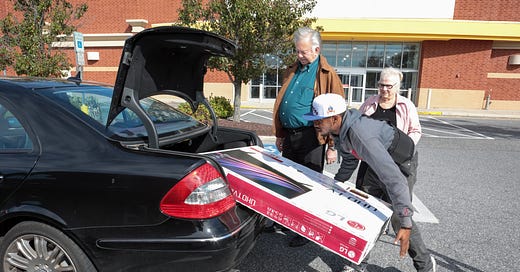“Anybody who thinks things are getting worse should go to Best Buy and notice the type of people who go to Best Buy.” iStockPhoto
This article was originally published in Forbes in September 2006 under the unfortunate title, “The American Standard of Whining.”
Adam Smith was a remarkably insightful guy. He not only figured out how expanding trade allows the division of labor, thereby creating wealth and raising living standards, he also realized how hard it is to get people to believe they’re better off than their ancestors. He discovered declinism way back in 1776.
“The annual produce of the land and labour of England...is certainly much greater than it was, a little more than a century ago, at the restoration of Charles II,” Smith wrote in The Wealth of Nations. “Though, at present, few people, I believe, doubt of this, yet during this period, five years have seldom passed away in which some book or pamphlet has not been published...pretending to demonstrate that the wealth of the nation was fast declining, that the country was depopulated, agriculture neglected, manufactures decaying, and trade undone. Nor have these publications been all party pamphlets....Many of them have been written by very candid and very intelligent people, who wrote nothing but what they believed, and for no other reason but because they believed it.”
Sound familiar?
Nowadays, candid and intelligent people—not to mention partisans—tell us that the average American’s standard of living has barely budged in decades. Supposedly only the rich are living better, while everyone else stagnates or falls behind.
And today’s gloom peddlers can claim to have scientific data on their side. According to the U.S. Census Bureau, the median real income of a full-time working male rose only 4% between 1981 and 2001, from $44,000 to $45,900 in today’s dollars.
If so, you have to wonder who's buying all those flat-screen TVs, serving precooked rotisserie chicken for dinner or organizing their closets with Elfa systems. “Anybody who thinks things are getting worse should go to Best Buy and notice the type of people who go to Best Buy,” says economist Robert J. Gordon of Northwestern University.
Gordon is the author of a much-cited study showing that from 1966 to 2001 real income kept up with productivity gains for only the top 10% of earners. What the pessimists who tout his study don't say is that, while Gordon does find that inequality is increasing, he's convinced that the picture of middle-class stagnation is false.
“The median person has had steadily improving standards of living,” he says. But real incomes have been understated. The problem lies in how the U.S. Bureau of Labor Statistics calculates the cost of living.
Do we want to know how much money it would take the typical American to buy today what the typical American bought 20 years ago? If so, what about all those things that didn't exist back then—not just iPods and mobile phones but everyday items like wrinkle-free pants, effective sunscreens, prewashed salads-in-a-bag or comfy hotel beds?
Price indexes also haven't kept up with changes in what consumers buy and when and where they shop. Wal-Mart's share of the U.S. grocery market is more than a fifth and is growing. Wal-Mart and other superstores charge up to 27% less for food than traditional supermarkets, estimate economists Jerry Hausman of MIT and Ephraim Leibtag of the Department of Agriculture. But the BLS doesn’t factor those lower prices into its inflation estimates. It simply assumes that Wal-Mart's price reflects worse service, and ignores the savings.
Government statisticians, Hausman complains, “want to act like accountants, and they don’t want to take economics into account at all.”
Using ACNielsen data from 61,500 households, Hausman and Leibtag calculate that grocery shoppers are 20% better off—not the full 27%—with a superstore shopping trip. “So some of the food isn’t quite as good or the diversity isn’t quite as good,” says Hausman. “But you still get a huge boost.”1
Since groceries make up 12% of household spending and as much as 25% for low-income Americans, this distortion significantly understates real incomes, especially at the bottom.
So why do we only hear bad news? Adam Smith knew.
“A continued Series of Prosperity,” he taught his rhetoric students, “would not give us near so much pleasure in the recital as an epic poem or a tragedy which make but one continued Series of unhappy Events.” In the rhetorical marketplace nothing succeeds like failure.
Aside from the demand side for pessimism, there’s a supply side. When I wrote this article, I received a payment of $2500, an inconceivably large sum today. When assessing journalistic reports on economic decline, it’s important to remember that journalists themselves have been significant victims of the economic and technological dynamism of the past few decades. Being a journalist in the 2000s was like being a steel worker in the 1980s. Esther Dyson saw the general trend in 1994: a flood of content, with competition driving the price of writing down near zero. And she wasn’t even thinking about what would happen to advertising.
For studies of how consumers divide their grocery shopping among various store formats, see work by marketing scholar (and friend of the Postrels) Edward Fox of SMU and co-authors, such as this 2004 paper.




